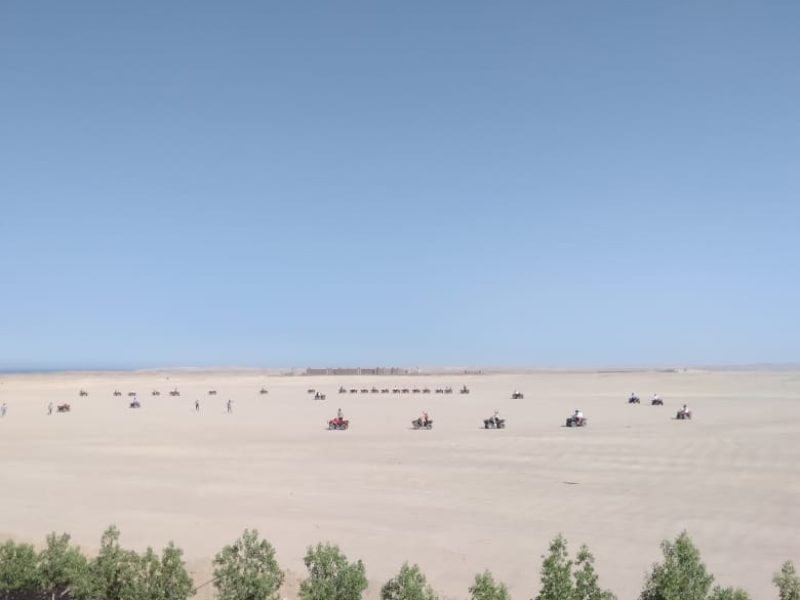Ancient Egypt, with its grand pyramids, enigmatic hieroglyphs, and remarkable pharaohs, continues to captivate the imagination of people worldwide. Among the numerous archaeological treasures that Egypt holds, the Valley of the Kings stands as a symbol of royal power and the afterlife. But not far from this famous necropolis lies another extraordinary site, the Valley of the Queens, offering an equally compelling and captivating narrative of ancient Egyptian history. In this extensive exploration, we will uncover the profound connection between the Valley of the Queens and the Valley of the Kings, shedding light on their shared historical significance and the unique stories they tell.

The Valley of the Kings – A Land of Pharaohs:
Nestled on the west bank of the Nile River, opposite modern-day Luxor, the Valley of the Kings, or “Bibān al-Mulūk” in Arabic, is an awe-inspiring archaeological site that served as the primary burial ground for Egypt’s pharaohs, queens, and nobility during the New Kingdom period (c. 16th to 11th centuries BCE). This valley, shrouded in the timeless allure of ancient Egypt, comprises a series of rock-cut tombs, richly adorned with mesmerizing hieroglyphs and vibrant frescoes.
The most iconic discovery in the Valley of the Kings was the tomb of Tutankhamun, unearthed by British archaeologist Howard Carter in 1922. This remarkable find sent shockwaves throughout the world, as it was a virtually intact burial chamber containing a wealth of treasures that provided an unprecedented glimpse into the grandeur of the New Kingdom.
But what is less known to the casual traveler is that the Valley of the Kings houses many other pharaohs, each with their own unique stories and legacies. Tombs like that of Seti I, Ramesses II, and Ramesses III, among others, boast intricate artwork and detailed inscriptions that reveal the history, beliefs, and aspirations of their occupants.
The Valley of the Queens – The Final Resting Place for Queens:
Just a stone’s throw from the Valley of the Kings, southwest of Luxor, lies the Valley of the Queens, or “Bibān al-Harām al-Malakī” in Arabic. While this valley might be less renowned than its illustrious neighbor, it possesses a history that is no less enchanting.
The Valley of the Queens, as the name suggests, primarily served as the burial site for queens, princesses, and other female members of the royal family. The tombs found here, like those in the Valley of the Kings, feature intricate artistry and well-preserved inscriptions, echoing the high status and reverence held by their occupants.
The Connection and Importance:
What ties these two valleys together is the intricate web of Egyptian royal history and the shared cultural, religious, and artistic legacy they represent. While the Valley of the Kings primarily housed the pharaohs, the Valley of the Queens was dedicated to the female members of the royal family. This distinction serves as a poignant reminder of the gender-specific roles within Egyptian society and the honor accorded to royal women.
In the artwork and inscriptions of both valleys, we find valuable insights into the lives, beliefs, and customs of ancient Egyptians. The decorations of the tombs in both valleys are richly adorned with references to the afterlife, religious rituals, and the Egyptian pantheon of gods. These elements not only provide a profound understanding of the culture and spirituality of the time but also grant a tantalizing glimpse into the mythology and cosmology that shaped ancient Egyptian thought.
Both valleys are a treasure trove of knowledge, bearing witness to the meticulous care and attention paid to preserving the memory of the deceased. Scenes of daily life, funerary practices, and the concept of the soul’s journey to the afterlife are illustrated in detail on the walls of these tombs.
Individual Tombs – Stories of Queens and Pharaohs:
In the Valley of the Kings, each tomb tells a unique story, a testament to the life and reign of the pharaoh buried within. These tombs are distinguished by their individual architectural designs and the themes of the decorations. The tomb of Seti I, for instance, is renowned for its magnificent wall paintings that depict scenes from the Book of the Dead, a guide to the afterlife. The tomb of Ramesses VI boasts striking astronomical scenes, hinting at the Egyptian fascination with the cosmos and the divine.
In the Valley of the Queens, the individuality of the tombs is equally pronounced. The resting place of Queen Nefertari, the beloved wife of Ramesses II, is perhaps the most famous in this valley. The tomb of Nefertari is celebrated for its exquisite artwork, portraying the queen in various divine and mythological roles. Her prominence in the Valley of the Queens emphasizes the crucial role that queens played in the religious and political aspects of ancient Egyptian life.
Not far from Nefertari’s tomb is the final resting place of Queen Titi, a daughter of Ramesses III. The tomb of Queen Titi is known for its depiction of the queen with the goddess Hathor, who was associated with music, dance, and love. These depictions offer a glimpse into the personal lives and devotions of these royal women.
 Cultural Significance and Afterlife Beliefs:
Cultural Significance and Afterlife Beliefs:
The Valley of the Kings and the Valley of the Queens provide a rich tapestry of evidence related to Egyptian culture and their beliefs regarding the afterlife. The striking artwork and inscriptions on the tomb walls offer insight into the religious practices, rituals, and cosmology of the time.
One recurring theme in both valleys is the concept of the soul’s journey to the afterlife. This journey was filled with challenges, trials, and tests, all of which were depicted in elaborate detail on the walls of these tombs. Scenes of the weighing of the heart, where the deceased’s heart was weighed against a feather, are a recurring motif, symbolizing the judgment of one’s deeds in life.
The presence of these shared themes in both valleys serves to connect the spiritual beliefs of the royals, emphasizing the importance of the afterlife and the desire to ensure a safe passage to it. The cultural and religious significance of these tombs is an essential element of understanding the broader context of ancient Egyptian civilization.
The Decline of Use:
As we traverse through time, it’s essential to acknowledge the changes that took place in Egypt’s political landscape, leading to a decline in the use of the Valley of the Queens. While the Valley of the Kings retained its significance as a burial site for powerful rulers, the Valley of the Queens gradually experienced a decrease in usage. This shift in focus is indicative of the changing cultural and political dynamics that shaped the trajectory of ancient Egypt.
The reasons for this decline in usage are multifaceted. Some tombs remained unfinished, others were repurposed, and a few were even used for secondary burials. The shifts in focus from one valley to another reflect the evolving dynamics of power, as well as the changing social and religious aspects of the time. By exploring the reasons behind this transition, we gain
insight into the dynamic and complex nature of ancient Egyptian society.
In Conclusion:
In the intertwined narratives of the Valley of the Queens and the Valley of the Kings, we discover a profound and multifaceted glimpse into the history of ancient Egypt. These two valleys, each with its unique role and occupants, provide a captivating view of the royal life and afterlife beliefs of this fascinating civilization.
As you explore the wonders of the Valley of the Kings, remember to take a short journey to the Valley of the Queens. The queens, princesses, and the secrets of ancient Egypt await your discovery. The connection between these two valleys serves as a bridge between the past and the present, a testament to the enduring fascination with the land of the pharaohs, its history, and its mysteries. Together, they tell a story of unity, culture, and spirituality, connecting us to a time long past but never forgotten.


Comment (0)